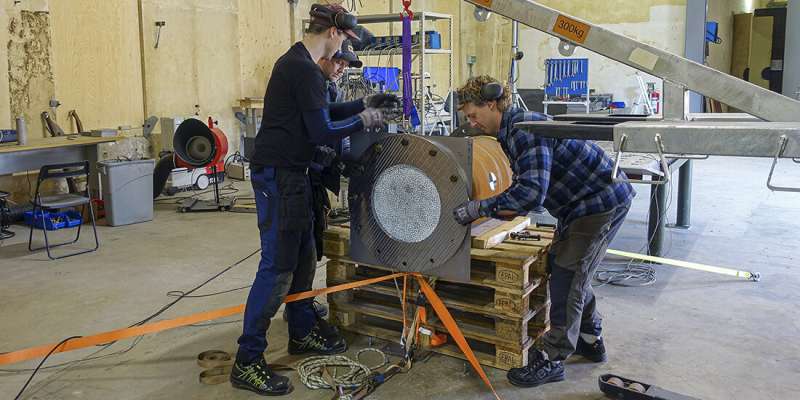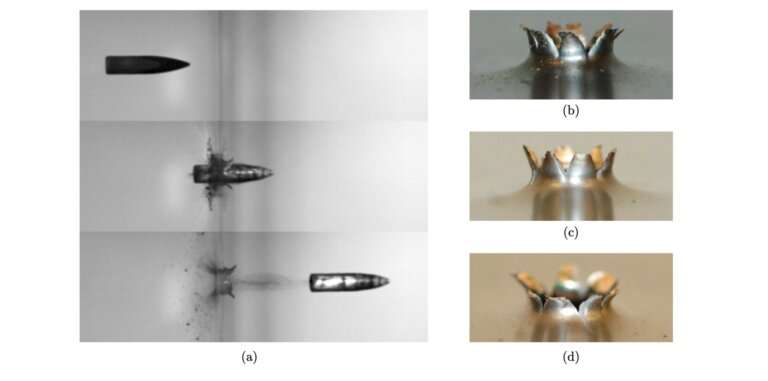This article has been reviewed according to Science X's editorial process and policies. Editors have highlighted the following attributes while ensuring the content's credibility:
fact-checked
trusted source
proofread
How do you create buildings that can withstand the most extreme stress loads?

Combined ballistic impacts pose a major challenge for engineers who build structures that must withstand extreme stresses. The combination of blast pressure and impact at high speed increases the chances of greater damage. Ph.D. candidate Benjamin Stavnar Elveli describes it as the scariest stress there is.
"These combined impacts work in the same way as shrapnel bombs," he says.
Infrastructure shift from massive and military to light and civilian
In the past, massive concrete military buildings formed the bulk of structures that were built to be protective against blasts. In recent decades, new threats have emerged, and the need to protect civilian buildings and structures in urban areas has increased.
This has fueled interest in lighter, thin-walled solutions that can withstand a great deal of deformation without cracking and collapsing.
Regulations don't yet reflect these changed needs. There are no standards for this type of load yet, and research in the field is very limited.
Elveli has investigated how different types of thin steel plates behave when exposed to extreme stress loads. His work can help to establish guidelines for how resistant, lightweight structures should be designed.
Initial projectiles do the most damage
Whether they occur in accidents or on purpose, explosions can cause massive damage. Debris and fragments can be torn loose from parts of buildings, cars, gravel or stones. When they hit, they can act like projectiles.
Elveli says that any buildings, cars or other objects in the vicinity would be exposed to a load that is more serious than if either stress load occurred alone. The damage is believed to be greatest when fragments hit first.
"That's because the structure already has a defect or weakness from the projectile and then has to withstand the shock wave itself," he says. "Most often, cracking and destruction start in the weak spots."
Safer structures, safer society
Elveli's Ph.D. is based on more than 80 small-scale explosion tests on three different types of steel. By combining physical experiments with theory and mathematical modeling, he has recreated the explosive loads in computer simulations. The aim is to gain as much control as possible over how structures react to such loads.
The more scientists understand about the actual physics of these loads, the more accurate, safe and sustainable solutions the construction engineers of the future can deliver.
Danger of overestimating strength
A shock wave can last for several milliseconds and cause great destruction over a large area. A fragment moves even faster and produces concentrated damage. Simulating this combined effect means that you have to describe two completely different phenomena in one and the same model. It's complicated.
"Often you'll end up with some sort of trade-off. In order to capture the local weaknesses that occur during the explosion, we need to determine how accurate the descriptions of the impact of the fragments should be. If we don't achieve full control over this, the model could overestimate the strength of the building to withstand the stress," says Elveli.
Need solutions that can be trusted
Overestimating strength can have fatal consequences. The solutions that construction engineers deliver have to be dependable. A large part of Elveli's doctoral work has been to investigate how accurate the models need to be to ensure reliable buildings.
A common approach has been to assume that the fragments hit before the shock wave happens. The physical experiments then have to be divided into two different sequences that follow each other. Often such studies use a simplified approach, where the test pieces have holes milled out by machine to mimic damage from real fragments.

Overestimating resilience
Elveli has compared the behavior of machined plates with plates hit with real projectiles. Real projectiles created small petal-like cracks and deformation around the points of impact, whereas the pre-formed defects had perfectly even edges.
The explosion tests showed that the destruction started in the cracks and spread outwards. The researcher thus shows that the simplified approach has weaknesses.
"Idealized defects, like in the machined plates, are easier to test and simulate. But because they lack the deformations and damage that occur in real explosions, there's a risk of exaggerating the strength of the materials in these models," he says.
Great need for computer simulations
Understanding the need to develop accurate computer simulations is easy enough. Researchers who work with strength calculations cannot blow up actual buildings to test their resilience.
Elveli has put a lot of work into designing controlled and reliable small-scale explosion tests. He believes that his research will be useful for other military and civilian researchers in the military. Precise and reliable simulations for industrial use are currently expensive and time consuming.
The many tests have produced large amounts of data that may interest the research and development departments of large companies. Elveli's work makes it possible to simulate how structures behave when they are bent, stretched or otherwise deformed.
In total, he has carried out 110 tests, of which 82 were explosion experiments. High-speed cameras filming 37,000 frames per second have captured the details as the steel plates are damaged. The study is published in the journal Engineering Failure Analysis.
More information: Benjamin Stavnar Elveli et al, Thin steel plates exposed to combined ballistic impact and partially confined airblast loading, Engineering Failure Analysis (2022). DOI: 10.1016/j.engfailanal.2022.106943




















